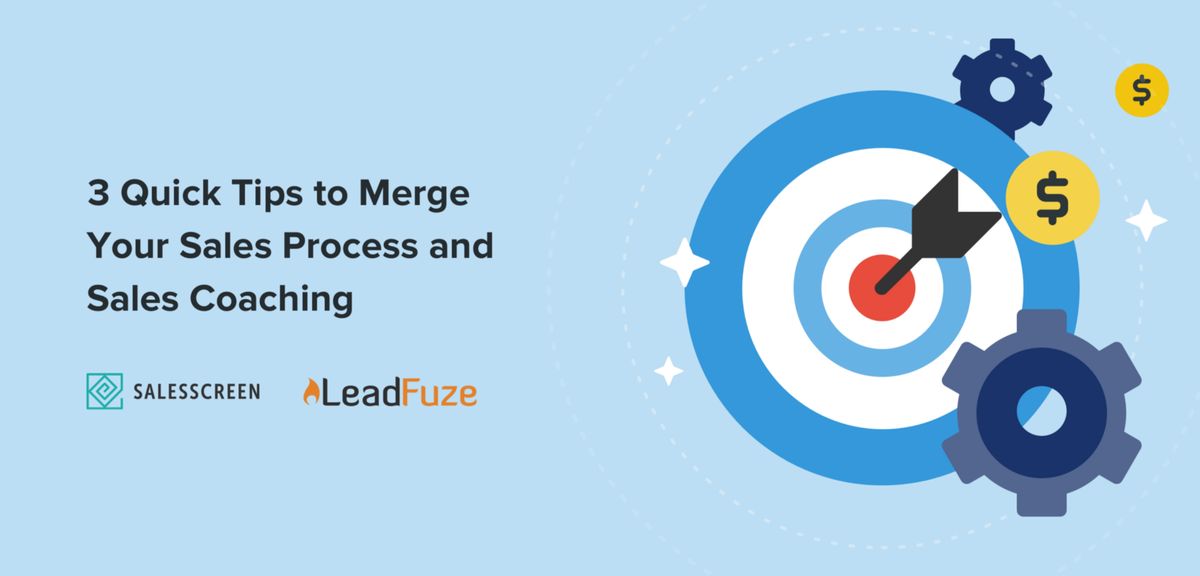
3 Quick Tips to Merge Your Sales Process and Sales Coaching
In this guest blog from Justin McGill of LeadFuze, we take a look into how to properly align your sales process with coaching for maximum sales effectiveness.
0 min read.
A great sales process is vital. A great coaching program for your reps is equally vital. The old saying goes, “two sides of the same coin”.
Founders, team leads, and marketing pros can be the greatest minds in funnel construction and management. In fact, there are multiple people who make their living hammering out and fine tuning the sequence leads flowing through various companies.
But even the most ironclad pipeline can be mishandled by untrained, under-motivated sales staff. One faulty step, and the whole process leaks money. This common problem demands a balance between the efficiency and accuracy of customer’s process and the coaching process.
Even though this makes sense, it’s not always to easiest to accomplish. These issues may be two sides of the sales coin, but they still are very different in nature.
- Sales process is mostly pragmatic.Do this, this and this. See the result. Tweak and repeat until the numbers get better.
- Sales coaching is mostly relational. Individualized, management, encouragement, rewards.
Side Note: There are pragmatic elements to coaching (i.e. metrics/goals tracking). Vice versa, there are relational elements to process (i.e. buyer behavior/psychology). In fact, this is why both concepts must merge for maximum growth and health of a business.
Lets sum up this intro with a quote and then get on to the practical tips for merging the two together in your business.
“A coach takes the ‘what to do’ and marries it with the ‘how to do it.’ Coaches are the ‘how to guys.’ Coaches are expected to get employees to performance levels to reach maximum potential. Coaches have to engage with players, encourage players, have rapport with players and earn trust from their players. When they do, they will be able to correct all of the little things that matter during the sales process. ” (emphasis mine) — Gary Milwit, SVP Sales at Stone Street Capital (source)
Tip #1: Know Your Sales Process
You may be thinking…
 But don’t be so hasty.
But don’t be so hasty.
To be honest, we see a lot of emails going out over at LeadFuze. Early on, we were able to see a major problem. What problem?
Well, few knew their sales process.
Most thought they would send out a catchy email or two and then leads will just start flowing in. But that didn’t happen. It was a major problem and has continued to shape and mold our own sales and onboarding process.
Like a weird, lead generation inception.
The point is, if you don’t know where your leads are coming from and the path that they will run through to become a client — you have no business worrying about making your sales team better.
Consistent growth will always elude you without a good map and process to guide the company and reps. Don’t fret, you don’t have to use the latest scientific methods to understand your funnel.
Here are the basic components.
Lead Acquisition
First on your list of to-dos is to find out where your leads are coming from and which methods are the most fruitful.
This one tip could help grow your business.
Tracking and viewing all roads that are coming into your sales team, narrowing them to the most effective, and then pumping all of your effort into those few inroads has a dramatic effect across the board.
Look at:
- Where your ad spend is going
- Who your current customers are (e.g. industry/market/role/company size)
- Buying or creating your own lead lists
Find out what you’re doing to get business, use the 80/20 rule and pump more time/effort into what works best.
Obviously, it helps with coaching. You’re able to set up standard operations in regard to acquisition.
If it’s via Facebook ads and inbound. Great, better hire inside sales reps that are good at creating content. Outbound? It’ll take a very detailed, highly motivated person. But it works (but we’re a bit biased).
Key Point: Understanding how your leads enter your sales funnel helps you define who you’re speaking to once they get there.
Lead Qualification
Once people get in your funnel, you start the qualification process. All of these brands/contacts aren’t going to be your customers (I know you know that).
But what many don’t realize is that you can find out who’s not going to buy — proactively.
You (or your reps that you’re coaching) can sniff out suspects and leave only those who are likely to end up in a real conversation or sales call (aka prospects). This, like I mentioned, is a very proactive step.
If your reps are well trained, they’ll be able to seriously weed the garden. Here are the two primary ways to move leads downstream in your funnel.
- Content: The right content not only attracts leads, but it can help move them further into your clutches. Things like demos, webinars, and white papers are excellent materials to entice those prospects into a conversation. But your reps will need to use (and possibly write) these tools seamlessly. The content comes from knowing who your leads are and reps using said content comes from proper training and coaching.
- Conversation: The best way to gauge the interest of leads in your funnel is to speak with them. Email is ok, but the phone is really where things happen. Reps should want to have 3–5 good conversations everyday. Chances are that those suspects aren’t going to want to talk, but if they do, ask them some qualifying questions to really prod them through.
Bonus Resource: Here’s a massive list of 42 qualifying questions from the folks at Close.io.
Client Acquisition (aka Closing)
It’s the bottom of the funnel that marks the end of your sales process. It’s where closing happens.
Organizations that have larger sales teams usually separate roles from development reps and closers (for good reason). It’s the most delicate dance in the process and it takes highly skilled and (insert attention-grabbing cough here) well-coached reps.
You can’t just walk in and say something like, “Coffee’s for closers!” Who does that?
When it comes to startups or companies entering the growth phase — you (the founder, head marketer, or sales manager) could still be closing the deals. This is necessary early on, but becomes a headache at a certain level of company complexity.
You can’t be the one who does it all.
In order to change it, you have to understand how you do what it is you do well enough to document the process and train others.
Tip #2: Understand Your Ideal Sales Team
If you’ve been in business and on the internet for more than five minutes, you’ve heard the term “buyer persona”. A great practice of finding out who your ideal clients are and marketing and developing a sales funnel for that specific group/person.
The cool thing about knowing your sales process is the ability it gives you to construct an ideal sales rep profile. This helps your coaching in three ways.
- Gives You a Goal: Your current team may not fit the bill of your profile. But that’s what coaching is for, right? Assess your current team and match them up to the profile. Doing this will give you a list of areas to work on and will likely help prioritize them.
- Helps Hire Better: There’s a lot of turnover in sales. But hiring well can lower that as well as make it easier for you or your managers to coach reps. If you’re looking for someone who fits into your company culture (aside from the stereotypical sales attributes), it’s less of a guessing game.
- You Don’t Waste Time: Coaching isn’t about wasting time on someone who doesn’t belong on your team. If you have an ideal profile and (after due process) someone isn’t going to make it into that picture — you’ll know it’s not necessarily your fault. It’ll save time and heartache.
Tip #3: Learn How to Coach (Confidently)
Ok, you understand how you sell your stuff and have an idea of who should be selling it for you.
Now you just have to coach.
First, we have to realize that coaching isn’t training per se. There are elements of each in the other, but there is one key difference.
Training is standard. Everyone learns the same thing the same way. Coaching is more personalized. Each person is different and may be motivated differently.
Example: A Baldwin brother may walk in and forbid anyone who doesn’t sell from drinking coffee in vulgar language. One person may close three deals that day while another puts in a two-week notice.
Here are a few tips to help you move your team to that ideal image and motivate them to move leads through that sales process.
- Measure: Your sales process is going to give you a ton of metrics to track. Leads coming in, sales qualified appointments (SQA's), contracts won/lost. You can't coach anyone without an understanding of where they are and where they need to be.
- Motivate: There are some reps that are financially motivated. They just want higher dollar amounts. Others are self-motivated and try to beat their own numbers. But most do want those things, but will need help.
- Automate: Coaching is likely not your only responsibility in the organization. Keeping tabs on even a small team can be gruesome. Using tools and software to automatically alert you (and your team) to new accomplishments or potential problems can create a more consistent coaching environment.
BTW, SalesScreen’s blog has a wealth of knowledge on the coaching process including here and here.
Learn How It All Works Together
If you understand the sales process, the ideal sales rep, and can monitor this progress — you can very quickly see how it all works together.
These three tips work together and coaching opportunities will be easily seen and addressed quickly.
Contributor bio
Justin McGill is the Founder of LeadFuze, an automated outbound marketing platform for companies that want to generate more leads.







